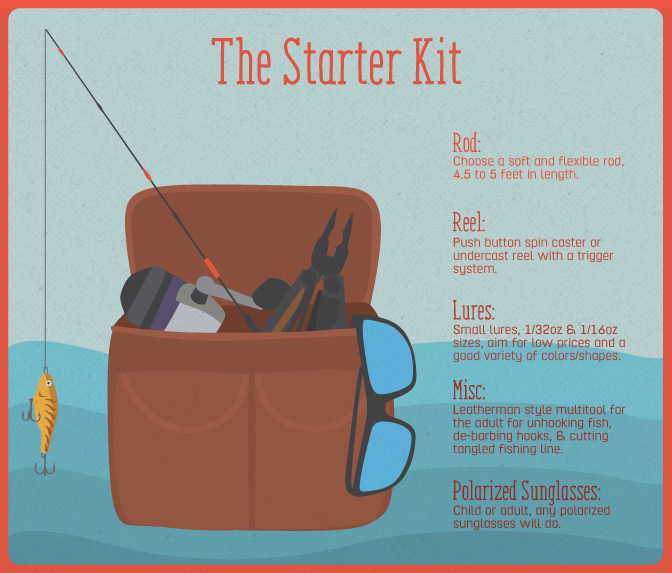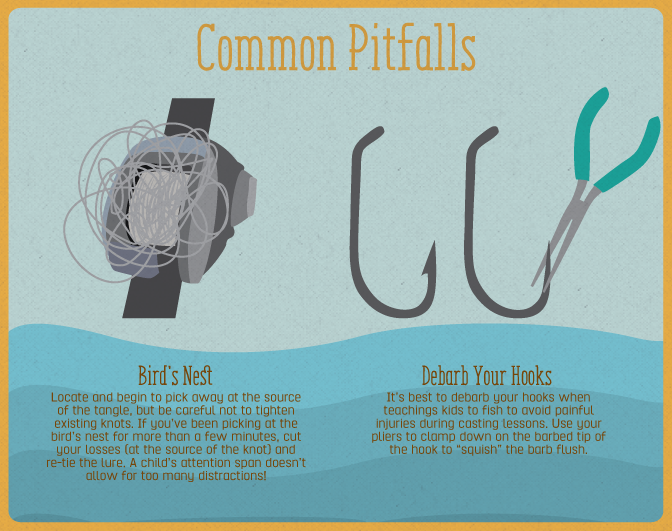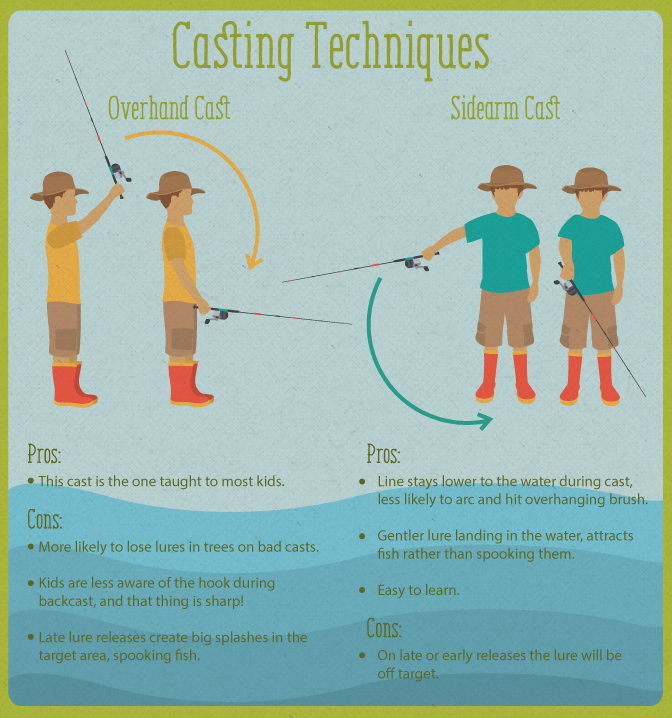TAKING KIDS FISHING
A fishing trip is much more than just going to catch fish. The excitement of getting the boat ready, packing a lunch, going over the checklist, picking out lures for the tackle box, buying worms, etc., is all part of the fun. The fishing experience teaches a child about patience, makes them aware of the sights and sounds of the outdoors, and provides a great sense of accomplishment from baiting a hook to catching that first fish. We all need to take the time to bring our children outside and teach them about taking ownership in caring for the natural environment. Help our Illinois youth get excited about fishing—if you can pass on your knowledge, you will be continuing a great tradition of exploring Illinois lakes and rivers.
Here are some ways to teach young people of all ages to fish and have a successful fishing experience:
Fishing License
Anyone under the age of 16 in Illinois does not need a license to fish.
Note: The adult accompanying a child fishing does not need a fishing license if he/she does not participate in fishing at all. Usually the adult casts, sets the hook, and/or helps the child reel in, in which case, that adult would need a valid Illinois fishing license.

"Leaves of three, leave it be!"
Safety
Many fishing related accidents can be avoided with some forethought. Act on the side of caution, watch over children diligently, and teach by example.
- Young children should always fish with an adult.
- When in a boat or canoe, ALWAYS wear a life jacket.
- If weather turns stormy, be cautious and seek shelter or end your trip early. If you hear thunder, it is time to get off the water!
- Protect young eyes and skin on sunny days. The sun reflects off the water surface, and it can be easy to get a sunburn or damage eyes. Always have young anglers wear a hat, sunscreen, and sunglasses.
- Those hooks are sharp! Teach children to always be aware of where their hook is and not to let it get near anyone else. Set good rules about looking around before anyone casts.
- It is a smart practice to use barbless hooks or pinch down the barbs on your own hooks.
- Be very careful of Poison Ivy. This often grows along disturbed areas around boat ramps or in the woods. If you go on a hike, stay on the trail.
Conservation
Always teach and practice the Anglers' Code of Ethics. Our lakes and rivers belong to everyone and we all must do our part to preserve them for future generations.
- Children and adult alike should keep only what you will eat and never wastefully discard any fish. For those fish you want to release, teach about best angling practices from our Catch-and-Release Guidelines.
- It is everyone’s responsibility to protect the outdoors. Do not throw gum wrappers, sandwich wrappers, soda cans, bait containers or any other trash in the water. Pack your trash out or dispose of it in a park garbage can.
- Teach kids that fishhooks and line can snag and kill fish, birds, turtles, small mammals and frogs when thrown into the water. These should be discarded in appropriate trash containers.
- Knowing the size and number of fish it is legal to keep is important for all. Talking about regulations with your child provides a great opportunity to discuss why these are necessary and how they can help keep fish populations healthy.
Where To Go?
Morning trips are best as the fish usually bite better and it is not too hot. A good place to teach a beginner is from a dock. This provides enough room to show kids how to put their worm on a hook, teach them proper casting, and observe other anglers. Sunfish often hang out around docks, making this a great way to view swimming fish and observe how fish are attracted to a lure.
To locate family friendly lakes in your area, see our lake selector page.
See our listing of family-friendly fishing events.
Child-Sized Equipment
Small hands can handle a kid-sized rod and reel much easier. For young children, toddler to preschool aged, a beginner fishing rod and reel combination can be found in the sporting good area of most department stores at a low price. Do not, however, choose the prepackaged rod sets with comic heroes on them for school-aged children. Instead, choose an ultra-light rod and reel.
- For kids, the most fun and least amount of line tangles are with spincast tackle.


Source: Fix.com
The Best Bait
Getting kids excited about fishing usually means actually catching a fish. Fortunately, most kids are happy with any size and kind of catch.
- The best luck will usually be with earthworms. Many a fishing adventure begins with digging for your own worms in the garden or collecting them after a good rain, however, a container of worms are easily purchased from the local tackle shop or marina.
- If the sunfish are really biting, you can use corn, pieces of a hot dog or even marshmallows.
Note: Live bait does require a barbed hook. With younger children, you can instead use lures and debarb your hooks.
Beginners Bait Guide (Download)
Casting Technique
Kids love to cast by themselves, and let's face it, casting is the most fun part of fishing for kids (until they catch a fish!). A few simple casting techniques should be all you need to get your fishing buddy casting on their own! If you've got your preferred method, teach your child that. Here a few pointers:

Source: Fix.com
I caught a fish! Now what?
In the excitement of catching a fish, here are some basic guidelines for the young angler:
- Landing a fish can take some practice. Teach the skill of “setting the hook” with one sharp pull up on the rod to force the hook into the fish’s mouth.
- Teach kids to keep the line tight and the rod tip up and don’t reel in the fish too quickly.
- It is tough for beginner anglers to know how to take a fish off the hook. Encourage kids to closely observe and help out until they feel they are ready to handle a fish and not get poked by spines.
- Before handling a fish, teach the importance of getting your hands wet. This prevents rubbing off the protective slime coating that fish have to prevent infection.
- What kind of fish is it? Point out colors, how to count spines, basic shapes, and other features that can teach kids about the differences of fish species. Download our Common Sport Fish Guide and refer to our Fish Species A-Z webpage.
- Because most fish have sharp spines that can poke your hand, always handle the fish carefully but firmly.
- If the hook is in too deep, it is best to cut the line about an inch from the fish’s mouth and let the fish go. Explain that many times the fish will get rid of the hook on its own and it is best to leave it in rather than cause internal damage trying to get it out.
- If you plan to release the fish, be sure to return it to the water as quickly as possible.
- Take a picture! Have your camera ready so you can show your friends and family the proud moment!
- Send us “Your First Fish” Photo and we will post it on our First Fish Page (coming soon!) for the world to see! An e-mail for uploading is coming soon, but until then, please send them to our Facebook page!
Keep the Whine Monster Away
Fishing can be an exciting activity when there is a fish on the line, but in between those moments, it is necessary to patiently sit quietly, which can be tough for a child for long periods of time. Here are some tips for keeping kids happily fishing.
- Make sure to bring plenty of water.
- Take note of where the restrooms are located.
- Pack a good lunch and plenty of snacks. You and your little partner can have a special fishing trip snack to enjoy at the end the day.
- If your young one is getting antsy, plan to take breaks for a nature walk.
- Point out other wildlife, like birds and turtle. Binoculars are a great item to have along when kids need a change of pace.
- To begin, take lots of shorter trips rather than a full day.
- A great day of fishing doesn’t always mean catching fish, so at the end of your trip, review the great sights, sounds, and fun you had.





From damselflies, to deer scat, to rat snakes to dragonflies, to painted turtles — there are so many things waiting to be discovered while you and your child look for signs of wildlife and critters that are connected to lakes and streams.
Keep an Angler Diary
Want to begin a great tradition? Start an angler diary with your child. Each time you go fishing, keep track of your catch, record conditions and what lures were successful, and take notes about the trip. Angler diaries are a great way to keep learning how to become a better angler: what fish were biting during the spring? What lures worked best on cloudy days? Did fishing early in the morning at your favorite lake make a difference? It is also a wonderful way to remember those special stories.
You can make your own journal, or download our Angler Diary Form and keep them together in a special binder. Add a few photos, and you have a wonderful lifetime gift for years to come.

Print out our checklist so your little partner and you can work together to get ready for your big outing! (download checklist)




